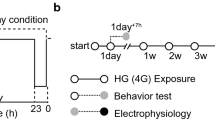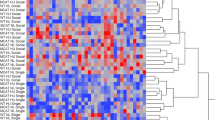Abstract
Long-term spaceflights and simulated microgravity negatively affect the number of cognitive functions, including memory, learning, spatial orientation, and decision making. At the same time, it was shown that cognitive processes are regulated by hippocampal neurogenesis. Here, we analyzed the effect of 3-day antiorthostatic (hindlimb) unloading on the activity of hippocampal neurogenesis in adult male CD1 mice. Our results showed that 3-day hindlimb unloading did not affect cell proliferation and population size of immature doublecortin-positive neurons but induced a decrease in the number of early nestin-positive neural progenitors. Analysis of signaling cascades involved in the regulation of hippocampal neurogenesis revealed no changes in the activity of ERK1/2 protein kinases but a significant increase in the expression and activity of the CREB transcription factor. In addition, mice exposed to 3-day hindlimb unloading demonstrated significantly elevated serum corticosterone concentrations and increased expression of glucocorticoid receptors in granule cells and hippocampal CA3 subfield, suggesting the development of stress response. Thus, stress caused by the adaptation to hindlimb unloading can be a crucial factor that mediates impairments of hippocampal neurogenesis under conditions of short-term simulated microgravity.







Similar content being viewed by others
REFERENCES
Altman J, Das GD (1965) Autoradiographic and histological evidence of postnatal hippocampal neurogenesis in rats. J Comp Neurol 124: 319–335. https://doi.org/10.1002/CNE.901240303
Baptista P, Andrade JP (2018) Adult hippocampal neurogenesis: Regulation and possible functional and clinical correlates. Front Neuroanat 12: 44.
Adami R, Pagano J, Colombo M, Platonova N, Recchia D,Chiaramonte R, Bottinelli R, Cannepari M, Bottai D (2018) Reduction of Movement in Neurological Diseases: Effects on Neural Stem Cells Characteristics. Front Neurosci 12: 336. https://doi.org/10.3389/fnins.2018.00336
Watson N, Ji X, Yasuhara T, Date I, Kaneko Y, Tajiri N, Borlongan C (2015) No pain, No gain: Lack of exercise obstructs neurogenesis. Cell Transplant 24: 591–597. https://doi.org/10.3727/096368915X687723
Popova NK, Kulikov AV, Naumenko VS (2020) Spaceflight and brain plasticity: Spaceflight effects on regional expression of neurotransmitter systems and neurotrophic factors encoding genes. Neurosci Biobehav Rev 119: 396–405.
Roberts DR, Albrecht MH, Collins HR, Asemani D, Spampinato VM, Xun Zhu, Chimowitz MI, Antonucci MU (2017) Effects of Spaceflight on Astronaut Brain Structure as Indicated on MRI. N Engl J Med 377: 1746–1753. https://doi.org/10.1056/NEJMoa1705129
Demertzi A, Van Ombergen A, Tomilovskaya E, Jeurissen B, Pechenkova E, Perri CD, Litvinova L, Amico E, Rumshiskaya A, Rukavishnikov I, Sijbers J, Sinitsyn V, Kozlovskaya I, Sunaert S, Parizel PM, Van de Heyning PH, Laureys S, Wuyts FL (2016) Cortical reorganization in an astronaut’s brain after long-duration spaceflight. Brain Struct Funct 221: 2873–2876. https://doi.org/10.1007/S00429-015-1054-3/FIGURES/1
Van Ombergen A, Demertzi A, Tomilovskaya E, Jeurissen B, Sijbers J, Kozlovskaya I, Parizel PM, Van de Heyning PH, Sunaert S, Laureys S, Wuyts FL (2017) The effect of spaceflight and microgravity on the human brain. J Neurol 264: 18–22. https://doi.org/10.1007/S00415-017-8427-X
Koppelmans V, Bloomberg JJ, De Dios YE, Wood SJ, Reuter-Lorenz PA, Kofman IS, Riascos R, Mulavara AP, Seidler RD (2017) Brain plasticity and sensorimotor deterioration as a function of 70 days head down tilt bed rest. PLoS One 12: e0182236. https://doi.org/10.1371/JOURNAL.PONE.0182236
Roberts DR, Zhu X, Tabesh A, Duffy EW, Ramsey DA, Brown TR (2015) Structural Brain Changes following Long-Term 6° Head-Down Tilt Bed Rest as an Analog for Spaceflight. Am J Neuroradiol 36: 2048–2054. https://doi.org/10.3174/AJNR.A4406
Casler JG, Cook JR (1999) Cognitive performance in space and analogous environments. Int J Cogn Ergon 3: 351–372.
Vecchio LM, Meng Y, Xhima K, Lipsman N, Hamani C, Aubert I (2018) The Neuroprotective Effects of Exercise: Maintaining a Healthy Brain Throughout Aging. Brain Plast 4: 17. https://doi.org/10.3233/BPL-180069
Dekeyzer S, De Kock I, Nikoubashman O, Bossche SV, Eetvelde RV, De Groote J M, Wiesmann M, Deblaere K, Achten E (2017) “Unforgettable”—a pictorial essay on anatomy and pathology of the hippocampus. Insights Imaging 8: 199. https://doi.org/10.1007/S13244-016-0541-2
Anand K, Dhikav V (2012) Hippocampus in health and disease: An overview. Ann Indian Acad Neurol 15: 239–246.
Li K, Guo X, Jin Z, Ouyang X, Zeng Y, Jinsheng F, Wang Y, Yao L, Ma L (2015) Effect of Simulated Microgravity on Human Brain Gray Matter and White Matter—Evidence from MRI. PLoS One 10: e0135835. https://doi.org/10.1371/JOURNAL.PONE.0135835
Yasuhara T, Hara K, Maki M, Matsukawa N, Fujino H, Date I, Borlongan CV (2007) Lack of exercise, via hindlimb suspension, impedes endogenous neurogenesis. Neuroscience 149: 182–191. https://doi.org/10.1016/j.neuroscience.2007.07.045
Nomura S, Kami K, Kawano F, Oke Y, Nakai N, Ohira T, Fujita R, Terada M, Imaizumi K, Ohira Y (2012) Effects of hindlimb unloading on neurogenesis in the hippocampus of newly weaned rats. Neurosci Lett 509: 76–81. https://doi.org/10.1016/j.neulet.2011.12.022
Qaisar R, Karim A, Elmoselhi AB (2020) Muscle unloading: A comparison between spaceflight and ground-based models. Acta Physiol 228: e13431. https://doi.org/10.1111/apha.13431
Morey-Holton ER, Globus RK (2002) Hindlimb unloading rodent model: Technical aspects. J Appl Physiol 92: 1367–1377.
Li Z, Theus MH, Wei L (2006) Role of ERK 1/2 signaling in neuronal differentiation of cultured embryonic stem cells. Dev Growth Differ 48: 513–523. https://doi.org/10.1111/j.1440-169X.2006.00889.x
Jansson LC, Åkerman KE (2014) The role of glutamate and its receptors in the proliferation, migration, differentiation and survival of neural progenitor cells. J Neural Transm 121: 819–836. https://doi.org/10.1007/s00702-014-1174-6
Schlett K (2006) Glutamate as a Modulator of Embryonic and Adult Neurogenesis. Curr Top Med Chem 6: 949–960. https://doi.org/10.2174/156802606777323665
Berezovskaya AS, Tyganov SA, Nikolaeva SD, Naumova AA, Merkulyeva NS, Shenkman BS, Glazova MV (2021) Dynamic Foot Stimulations During Short-Term Hindlimb Unloading Prevent Dysregulation of the Neurotransmission in the Hippocampus of Rats. Cell Mol Neurobiol 41: 1549–1561. https://doi.org/10.1007/s10571-020-00922-2
Berezovskaya AS, Tyganov SA, Nikolaeva SD, Naumova AA, Shenkman BS, Glazova MV (2021) Plantar stimulations during 3-day hindlimb unloading prevent loss of neural progenitors and maintain erk1/2 activity in the rat hippocampus. Life 11(5): 449. https://doi.org/10.3390/life11050449
Charvet CJ, Finlay BL (2018) Comparing adult hippocampal neurogenesis across species: Translating time to predict the tempo in humans. Front Neurosci 12: 706. https://doi.org/10.3389/FNINS.2018.00706/FULL
Snyder JS, Choe JS, Clifford MA, Jeurling SI, Hurley P, Brown A, Kamhi JF, Heather A Cameron HA (2009) Adult-Born Hippocampal Neurons Are More Numerous, Faster Maturing, and More Involved in Behavior in Rats than in Mice. J Neurosci 29: 14484–14495. https://doi.org/10.1523/JNEUROSCI.1768-09.2009
Ortega-Martínez S (2015) A new perspective on the role of the CREB family of transcription factors in memory consolidation via adult hippocampal neurogenesis. Front Mol Neurosci 8: 46. https://doi.org/10.3389/FNMOL.2015.00046/BIBTEX
Bourtchuladze R, Frenguelli B, Blendy J, Cioff D, Schutz G, Silva AG (1994) Deficient long-term memory in mice with a targeted mutation of the cAMP-responsive element-binding protein. Cell 79: 59–68. https://doi.org/10.1016/0092-8674(94)90400-6
Böer U, Alejel T, Beimesche S, Cierny I, Krause D, Knepel W, Flügge G (2007) CRE/CREB-Driven Up-Regulation of Gene Expression by Chronic Social Stress in CRE-Luciferase Transgenic Mice: Reversal by Antidepressant Treatment. PLoS One 2: e431. https://doi.org/10.1371/JOURNAL.PONE.0000431
Chen Y, Fenoglio KA, Dubé CM, Chen Y, Fenoglio KA, Dubé CM (2006) Cellular and molecular mechanisms of hippocampal activation by acute stress are age-dependent. Mol Psychiatry 11: 992. https://doi.org/10.1038/SJ.MP.4001863
Bernal A, Arranz L (2018) Nestin-expressing progenitor cells: function, identity and therapeutic implications. Cell Mol Life Sci 75: 2177. https://doi.org/10.1007/S00018-018-2794-Z
Marei HES, Ahmed AE, Michetti F, Pescatori M, Pallini R, Casalbore P, Cenciarelli C, Elhadidy M (2012) Gene Expression Profile of Adult Human Olfactory Bulb and Embryonic Neural Stem Cell Suggests Distinct Signaling Pathways and Epigenetic Control. PLoS One 7: e33542. https://doi.org/10.1371/JOURNAL.PONE.0033542
Pechnick RN, Zonis S, Wawrowsky K, Cosgayon R, Farrokhi C, Lacayo L, Chesnokova V (2011) Antidepressants Stimulate Hippocampal Neurogenesis by Inhibiting p21 Expression in the Subgranular Zone of the Hipppocampus. PLoS One 6: e27290. https://doi.org/10.1371/JOURNAL.PONE.0027290
Warner-Schmidt JL, Duman RS (2006) Hippocampal neurogenesis: opposing effects of stress and antidepressant treatment. Hippocampus 16: 239–249. https://doi.org/10.1002/HIPO.20156
Boucher P, Plusquellec P (2019) Acute Stress Assessment From Excess Cortisol Secretion: Fundamentals and Perspectives. Front Endocrinol (Lausanne) 10: 749. https://doi.org/10.3389/FENDO.2019.00749/BIBTEX
Sakamoto K, Karelina K, Obrietan K (2011) CREB: a multifaceted regulator of neuronal plasticity and protection. J Neurochem 116: 1. https://doi.org/10.1111/J.1471-4159.2010.07080.X
ACKNOWLEDGMENT
A part of this study was implemented on the equipment of the Center for Collective Use at the IEPhB (441590).
Funding
This work was supported by the Russian Foundation for Basic Research (RFBR) grant 20-015-00062 and the state assignment to the IEPhB no. 075-0152-22-00.
Author information
Authors and Affiliations
Contributions
E.A.О.—Western blot analysis, immunohistochemistry, immunofluorescence studies; А.А.N.—experimental design, discussion of the results; Y.S.G.—data collection, Western blot analysis; V.Т.B.—data processing, manuscript editing; Е.А.L.—provision of experimental studies; E.V.Ch.—data discussion and interpretation; M.V.G.—conceptualization, experimental design, manuscript writing.
Corresponding author
Ethics declarations
CONFLICT OF INTEREST
The authors declare that they have neither evident nor potential conflict of interest related to the publication of this article.
Additional information
Translated by A. Polyanovsky
Russian Text © The Author(s), 2022, published in Rossiiskii Fiziologicheskii Zhurnal imeni I.M. Sechenova, 2022, Vol. 108, No. 7, pp. 861–873https://doi.org/10.31857/S0869813922070081.
Rights and permissions
About this article
Cite this article
Oleynik, E.A., Naumova, А.А., Grigorieva, Y.S. et al. Neurogenesis in the Hippocampus of Mice Exposed to Short-Term Hindlimb Unloading. J Evol Biochem Phys 58, 1119–1129 (2022). https://doi.org/10.1134/S0022093022040159
Received:
Revised:
Accepted:
Published:
Issue Date:
DOI: https://doi.org/10.1134/S0022093022040159




